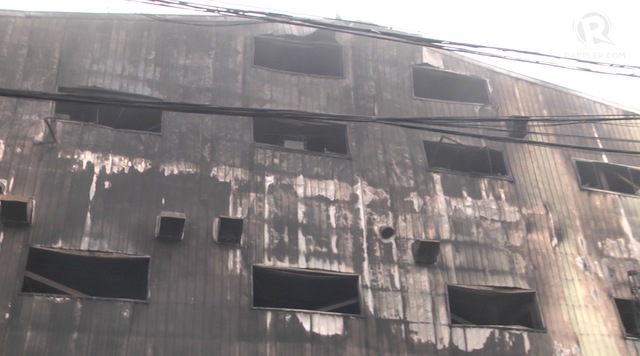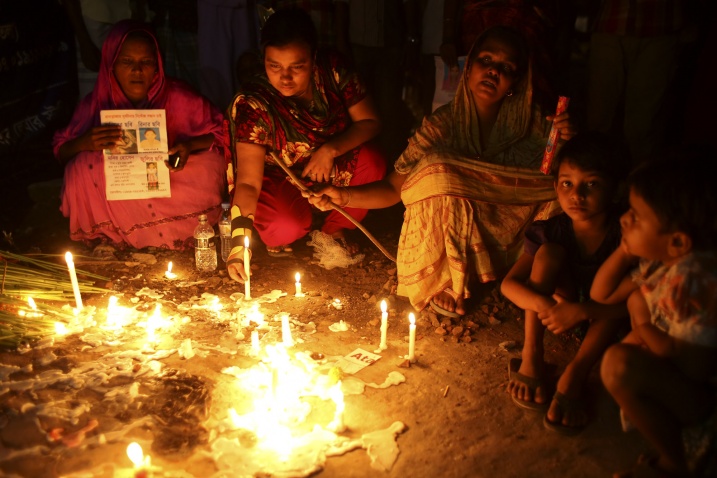In the Philippines, House Technologies Industries owns a three-story factory in the Cavite Export Processing Zone, also known as the Cavite Economic Zone, south of Manila. On February 1, in the evening during shift change, a fire broke out. That fire raged for two full days before it was finally put out. Fire exits were locked, windows barred, corridors far too narrow to allow for quick passage: this was no accident. Yet again, as in the Kentex fire two years ago, this fire and those workers burned to death and the workers critically injured are part of the brutal architecture of industrial production. Every report covers up more than it reveals, and the workers, charred beyond recognition, wait for nothing now. What have the owners, including the State, learned in the years since the Kentex fire? They’ve learned the art of cover-up.
According to a report released by the Center for Trade Union and Human Rights, “Nearly all those interviewed … believed that many were trapped inside and have died. The stream of people desperately seeking to go out of the building was too big for the employee’s passageways and fire exits to accommodate. There were accounts that the fire exits were locked, forcing escaping workers to break windows as their means of egress. Workers claim that the company’s exit stairs land inside the building, or in the delivery section within the company compound. There was no exit that lands on the streets. A witness shared that he did not see anyone who escaped using the same exit he went out of, only through passageways and windows.
“There were accounts that windows were tightly screwed on window sill and witnesses saw workers including a pregnant woman jumped out from the third floor window. Other witnesses narrated that on their way out, they left behind workers on the floor, unconscious. They also saw flames rapidly chasing the escaping workers. Relatives of those who were injured also told that their relative was able to escape by crawling over and stepping on unconscious bodies on the floor, whom they presumed dead.
“The National Building Code of the Philippines (Republic Act 6541) and the Occupational Safety and Health Standards prescribed specific design, size, width and dimension for fire exits and passageway, particularly in structures for different loads and those that contain highly combustible materials for safer egress and other. Examining the accounts, the law’s prescriptions were amiss in the HTI fire, the biggest fire in the country’s history of Export Processing Zones (EPZs).”
In its conclusion, the Commission notes, “There were more women working in the Quality Control in the 3rd floor including a pregnant woman who jumped out from the 3rd floor window and more possibly trapped. From the reported 126 workers injured brought to hospital … there were 25 women … Where were those women workers? What happened to that pregnant woman? The distance from the ground floor to the third floor is high, as vertical clearance alone from the 1st to the 2nd floor, where containers are brought in, is estimated to about 18 feet (5.49 meters) high.”
We have been here before. The State can find violation of safety regulations, or not, and the trade unions can protest working conditions and demand an independent investigation, but the factories and sweatshops go up, bars cover the windows, doors are locked from the outside, and no one does anything. This is the second fire at the HTI factory in four years. In the first fire, HTI was exonerated of any fault. After this fire, HTI called in employees and told them to keep quiet. Some say the company forced them to erase video and photo evidence from their phones. Some say the company only counted full time employees in its tally. HTI is the largest employer in the Cavite Economic Zone.
From the Triangle Shirtwaist Factory on March 25, 1911, in New York, to the Kader Toy Factory in 1993 Bangkok, to the Zhili Handicraft Factory in 1993 Shenzen, to the Tazreen Fashions Factory in 2012 Dhaka, and to the Kentex Manufacturing Corporation in 2015, to the House Technologies Industries in 2017, the architecture is the same, as are the smoke, stench, exploitation, workers and bosses. The factory was built as a slaughterhouse. When the flames burst and the workers’ bodies exploded, there was no accident. Today, March 26, 2017, we begin the 117th year of the Triangle Shirtwaist Factory Fire Era, in which we can eradicate epidemic diseases and yet stand by and watch as the factory fires grow larger, more intense, and more lethal, and women jump from windows to the hard earth below.

After the fire
(Photo Credit 1: CTUHR) (Photo Credit 2: Rappler / Naoki Mengua)

